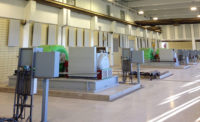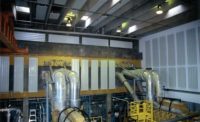According to the Centers for Disease Control (CDC), some 22 million U.S. workers are currently exposed to hazardous noise conditions. Excessive workplace noise is linked not only to hearing loss, but also to a host of other medical conditions, including cardiovascular diseases such as hypertension, arteriosclerosis, and coronary heart disease (CHD).
Industrial plants can be loud, acoustically harsh environments. The combination of high ceilings, reflective surfaces and the din from heavy machinery creates an optimal environment for reverberation and excessive noise. Besides being unhealthy, these conditions can hinder personnel communications, decreasing productivity and worker morale, creating a tough challenge for facility managers.
That is especially true for wastewater treatment plants where the combination of high-speed, high volume air blowers and concentrators and hard, easily cleanable surfaces (walls, ceilings and floors) combine to create a unique noise problem.
Sound-absorbing panels
One of the best solutions to the problem of excessive industrial noise is the installation of acoustic, sound-absorbing panels on the walls and ceilings of industrial spaces. Acoustic panels can be constructed of materials that are easily cleanable and sanitary such as aluminum or stainless steel. Depending on the severity of the noise problem, as little as one-third of the available wall and ceiling area must be covered with acoustic panels to provide noise reduction that meets OSHA industrial noise standards. Area-wide noise reduction can eliminate the need for individual hearing protection, improving operator communications.
To reduce the noise safety hazard inherent in the wastewater treatment process, acoustic panels for noise remediation were included in the design specifications for a new wastewater treatment plant in Modesto, California.
Modesto, a city in central California with a population of 212,000 people, operates a state-of-the-art, two-location wastewater treatment process that provides water clean enough to be used for irrigation or for discharge into the San Joaquin River.
Whining high-speed blowers
Effluent from the Sutter Primary Treatment Facility, which handles an average of 20 MGD (million gallons/day) of raw wastewater, is pumped six miles to the Jennings Secondary/Tertiary Treatment Plant, a recently redesigned and upgraded facility that includes anoxic and aerobic secondary treatment, membrane filtration and UV disinfection. The new Jennings facility handles about 12.6 MGD of treated wastewater and went online in the spring of 2016.
In the new aeration blower building (ABB) and membrane blower building (MBB), noise reduction was specified to cope with the whine generated by the high-speed blowers housed in each. Both buildings are constructed of concrete floors and walls, with steel deck ceilings. The ABB has dimensions of 49 ft. wide by 93 ft. long with a ceiling height of 20 ft. The MBB is 49 ft. wide by 73 ft. long with a ceiling height of 19 ft. Only half of each of the buildings is currently being used, as both are designed for 100-percent capacity increase. The ABB currently has six 300HP blowers operating at approximately 19,000 rpm and each moving 6,000 scfm of air. The MBB houses four 150 HP blowers running at approximately 15,000 rpm and moving 3,800 scfm of air each.
The design specs called for the use of perforated, v-ridged aluminum acoustic panels to tame the excessive noise. The panel complement in the ABB was as follows: 154 30 in. x 96 in. panels and 3 30 in. x 48 in. panels. In the MBB, 109 30 in. x 96 in. panels, 15 30 in. x 72 in. panels, and 14 30 in. x 48 in. were installed. Panels of different dimensions were specified to fit within existing utility and structural elements on the walls of the two buildings.
According to Aaron Trott, Plant Maintenance Superintendent, the panels have done their job. “Both rooms are very comfortable workspaces. In contrast to other wastewater treatment plant blower rooms, hearing protection is not required,” he said.



